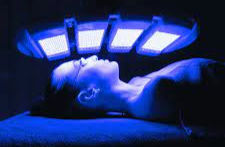Phototherapy Light Devices
- Dr ATHEENA MILAGI PANDIAN SHANMUGANATHAN
- Oct 31, 2024
- 3 min read
Phototherapy Light Devices are innovative therapeutic tools that utilize specific wavelengths of light to treat various medical conditions, particularly those related to skin disorders, mood disorders, and certain neonatal conditions.

This non-invasive treatment modality harnesses the power of light to promote healing, reduce inflammation, and alleviate symptoms, making it a valuable option in both dermatological and psychiatric practices. Phototherapy has gained recognition for its efficacy in treating conditions such as psoriasis, eczema, vitiligo, and seasonal affective disorder (SAD), as well as in managing neonatal jaundice.

The underlying principle of phototherapy involves the absorption of light by specific chromophores in the skin, which leads to a series of biological responses. For skin conditions, ultraviolet (UV) light is commonly used in controlled doses to slow down the excessive growth of skin cells associated with disorders like psoriasis. UVB phototherapy, in particular, has proven effective in reducing inflammation and promoting skin clearance. In addition to UV light, blue light therapy has been employed to treat acne by targeting the bacteria responsible for the condition, leading to reduced inflammation and breakout frequency. Furthermore, red and near-infrared light therapies have gained traction for their ability to stimulate cellular processes, enhance collagen production, and promote tissue repair, making them beneficial for wound healing and skin rejuvenation.

In the realm of mood disorders, light therapy, particularly with bright white or blue light, has been shown to be effective in alleviating symptoms of seasonal affective disorder (SAD) and other forms of depression. The theory behind this application is that exposure to bright light can help regulate the body’s circadian rhythms and melatonin production, which are often disrupted in individuals suffering from seasonal depression. By simulating natural sunlight, phototherapy devices can help improve mood, increase energy levels, and enhance overall well-being, providing an accessible and effective treatment option for those affected by seasonal changes in light.

Phototherapy is also widely used in neonatal care, particularly for treating jaundice in newborns. Neonatal jaundice is a common condition characterized by elevated levels of bilirubin in the blood, which can lead to serious complications if left untreated. Phototherapy light devices emit blue light that helps convert bilirubin into a form that can be easily excreted by the body. This treatment is typically administered in a hospital setting, where infants are placed under phototherapy lights while their bilirubin levels are closely monitored. The non-invasive nature of this therapy makes it a safe and effective solution for managing jaundice in newborns.

While phototherapy light devices offer numerous benefits, there are also considerations and potential risks associated with their use. One primary concern is the risk of skin damage or burns, particularly with prolonged exposure to UV light. Therefore, treatment protocols must be carefully designed to balance efficacy with safety, ensuring that patients receive the appropriate doses of light without experiencing adverse effects. Additionally, users of phototherapy devices must be educated on the proper usage and potential side effects, such as skin irritation or photosensitivity, to maximize treatment benefits and minimize risks.

Furthermore, the accessibility of phototherapy devices can vary, with some requiring specialized equipment found in clinical settings, while others are available for home use. The emergence of at-home phototherapy devices, particularly for skin conditions, has made treatment more convenient for patients, allowing them to integrate therapy into their daily routines. However, the effectiveness of at-home devices can vary based on their design, light intensity, and treatment protocols. As such, it is essential for patients to consult with healthcare professionals to determine the most suitable options for their specific conditions.

Research continues to explore the potential applications and enhancements of phototherapy light devices. Innovations in LED technology have led to the development of more portable and efficient devices that can deliver specific wavelengths of light with precision. These advancements are paving the way for personalized phototherapy treatments tailored to individual patient needs and preferences. Additionally, ongoing studies are investigating the effects of combining phototherapy with other therapeutic modalities, such as pharmacological treatments or behavioral therapies, to enhance overall treatment outcomes.

In summary, phototherapy light devices represent a versatile and effective approach to treating a range of medical conditions, particularly in dermatology, psychiatry, and neonatal care. By harnessing the therapeutic properties of light, these devices offer non-invasive solutions that promote healing, reduce symptoms, and improve patient quality of life. As technology advances and research progresses, the potential for phototherapy continues to expand, offering exciting prospects for more effective and personalized treatment options in the future.

Comments